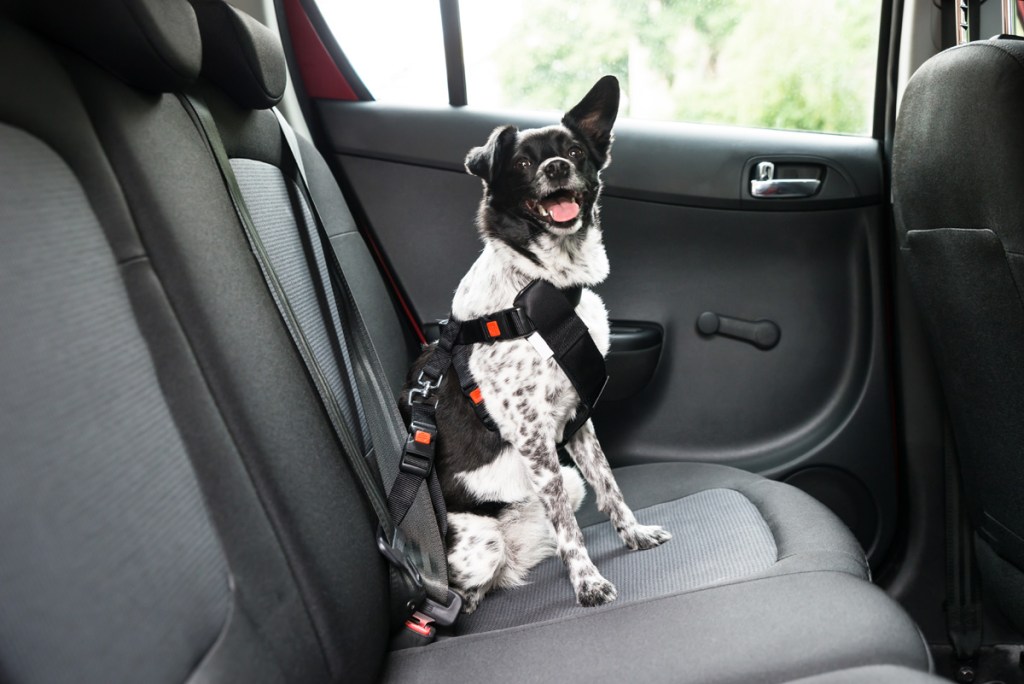If you’ve ever kissed your dog goodbye before leaving on vacation, you know the heartbreak. Why not avoid it next time and take your pooch along for the ride? While your pup may be used to short trips to the park or pet store, it’s a good idea to extend the time spent in the car before embarking on a long road trip. Also, use positive reinforcement training to teach your dog to jump in and out of the car on command. This will pay off at rest stops once your trip is underway.
Think safety first when traveling with your dog
Keep your dog restrained while driving
Don’t assume that because your dog sits or lies quietly in the car that she doesn’t need a restraint. A calm dog will be thrown with the same amount of force as an active dog in a crash or sudden stop. According to the AAA, if a car crashes at 25 mph, an airborne dog can develop projection forces equaling 40 times his or her weight.
When choosing a restraining device, it’s important to remember that there are no government standards for pet-safety products. The nonprofit Center for Pet Safety (CPS) does independent crash tests of crates, harnesses, and pet carriers using crash-test-dummy dogs. The organization offers a list of CPS-certified products for consumers.
Pet restraint options include:
- Pet seat belts and harnesses – Some travel harnesses prevent distraction, while others protect your dog in case of an accident.
- Crates and carriers – Experts at the Humane Society of the United States recommend crating dogs while traveling in cars.
- Booster seats – These seats attach to the car seatback. Many include straps, which should be attached only to the dog’s harness and never the collar, as that poses a choking hazard. These seats should never be used in the front seat of the car where a deployed airbag could cause injury or even kill a small dog.
- Barriers – Barriers come in a variety of sizes and materials and keep dogs from jumping — or being thrown — into the front of the car.

Don’t allow your dog’s head to hang out the car window
While it certainly looks like fun, the American Veterinary Medical Association (AVMA) cautions against allowing dogs to stick their heads out of car windows while in motion. This puts them at high risk of eye, ear, face, and mouth injury from airborne objects. Additionally, dogs can fall out the window in a collision or abrupt turn and may jump out after prey.
Never leave your dog in a hot car
Every year, hundreds of pets die from heat exhaustion because they are left in parked cars. According to the AVMA, the temperature inside your car can rise almost 30 degrees within 20 minutes. Even on days that don’t seem hot to you, leaving your pet in a car can put her at serious risk of illness and even death.
Dealing with motion sickness
Younger dogs are more likely to suffer from motion sickness. It’s believed this is because the parts of the inner ear involving balance aren’t fully developed. Symptoms of motion sickness include excessive drooling, restlessness, yawning, whining, vomiting, and diarrhea. If your dog does appear distressed, stopping to take a short walk may help relieve the symptoms. If your dog is susceptible to motion sickness, discuss medication options with your veterinarian before hitting the road.
To help avoid motion sickness:
- Don’t feed your dog for 12 hours before hitting the road.
- Keep the interior of the car cool.
- Choose soft, calming music for the trip.
- Place a T-shirt with your scent in the crate or carrier to help your dog relax.

Zivica Kerkez/Shutterstock
Before you leave for your trip
Check ID tags
Make sure contact information is current on collar ID tags. If your dog is microchipped, check that the information is current on the microchip registry site. Also, check your dog’s collar, harness, and leash to make sure there’s no fraying or damage that could cause them to break. Consider bringing backups of each just in case.
Your dog’s packing list should include:
- Food and water bowls
- Food
- Water
- Treats
- Any necessary medications and a copy of your dog’s health records
- Flea and tick preventatives and tick remover
- Favorite toys
- Clothing (depending on the time of year)
- Favorite bed and blanket
- Brush and dry shampoo
- First-aid kit (you can find handy carry cases at major pet stores or online)
- Poop bags
- Towels for drying off the dog on wet days or cleaning up drool
Once on the road, you’ll need to plan a stop every two or three hours to allow your dog to take a bathroom break, grab a drink, and get in a walk. And finally, it’s so much fun hitting the road with your dog, be sure to enjoy every minute of the adventure.



